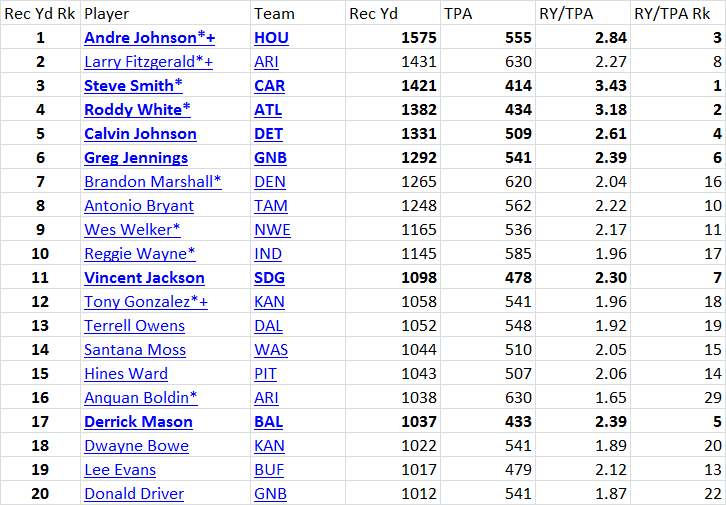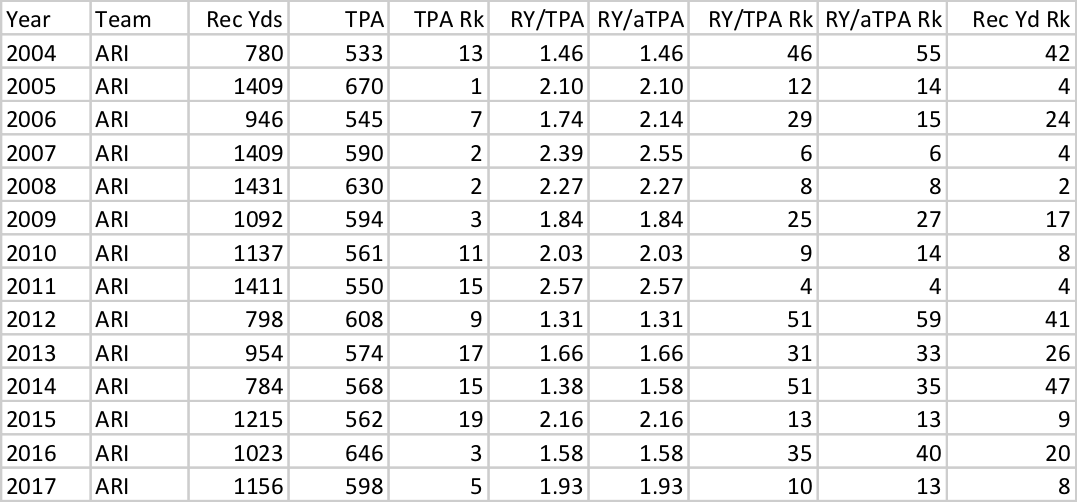Yesterday, I looked at the leaders in Gray Ink in Receiving Yards per adjusted Team Pass Attempt. There was a pretty notable name absent from that list: Larry Fitzgerald, who currently ranks 3rd on the all-time receiving yards list. So what gives? The graph below shows Fitzgerald’s relevant statistics from every season of his career.
For example, in 2004, playing for Arizona, he had 780 receiving yards and his team had 533 Team Pass Attempts (excluding sacks). The Cardinals ranked 13th Team Pass Attempts that season. Fitzgerald averaged 1.46 Receiving Yards/Team Pass Attempt, and 1.46 Receiving Yards/adjusted Team Pass Attempt (meaning he played a full season). He ranked 46th in RY/TPA and 55th in RY/aTPA. He also ranked 42nd in raw receiving yards.
Fitzgerald has just 15 points of Gray Ink in Receiving Yards/adjusted Team Pass attempt: a 6th-place finish in ’07 gave him 5 points, an 8th-place finish in ’08 gave him 3 points, and a 4th-place finish in 2011 gave him 7 points. Even using RY/TPA — to give him credit for staying healthy — would only add 3 points, due to a 9th place finish in 2010 and a 10th-place finish in 2017. Meanwhile, Fitzgerald has 38 points of Gray Ink in raw receiving yards.
So let’s investigate.
- In 2005, Fitzgerald ranked 4th in receiving yards with 1,409. That sounds impressive, and it is impressive, except Arizona also threw a whopping 670 passes that year! Fitzgerald barely lead the team in receiving yards — Anquan Boldin had seven fewer yards despite missing two games. On a team that was one of the most pass-heavy in history, Fitzgerald’s 4th-place rank is less impressive. He ranked 14th in RY/aTPA — that may be too far of a penalty, but ignoring the pass-happy nature of the Cardinals that year isn’t the right solution, either. So Fitzgerald loses 7 points of Gray Ink this season.
- In 2007, Fitzgerald ranked 4th in receiving yards, while Kurt Warner (11 starts), Matt Leinart (5 starts) and the Cardinals ranked 2nd in team pass attempts. Fitzgerald missed one game (he ranked 3rd in receiving yards/game), and his 2.55 RY/aTPA was the 2nd-best of his career. This was a great season, and Fitzgerald only moves down from 4 to 6 due to the pass-happy nature of the Cardinals offense, as Fitzgerald lost 2 points of Gray Ink this season.
- In 2008, FItzgerald ranked 2nd in receiving yards, but yet again, Arizona ranked 2nd in pass attempts. The Cardinals had 630 pass attempts this season, trailing only the Saints (636). Fitzgerald had 1,431 receiving yards and would go on to have a legendary postseason run, but he only ranked 8th in RY/aTPA. Let’s take a look at the top 20 leaders in receiving yards in 2008, and where they ranked in RY/TPA (since Fitzgerald has the same rank in RY/TPA as in RY/aTPA, to simplify the analysis, we’ll just use RY/TPA).

Smith, White, and Johnson all were within 100 receiving yards of Fitzgerald and played on teams that had over 100 fewer pass attempts. It doesn’t feel like a stretch to say that they were more productive. Jennings becomes a closer case, and it’s easy to make arguments for Fitzgerald over Jackson and Mason (bolded above). But I think Johnson, Smith, White, and Johnson all have clear arguments over Fitzgerald for 2008. It’s also worth noting that Fitzgerald only had 29% of Cardinals receiving yards that year, which ranked 17th in the league. Mason, for example, had 34% of Baltimore receiving yards, while Jennings had 32% of Packers receiving yards (Jackson had only 27% of Chargers receiving yards; the difference there being he played with a star quarterback that season, so he does better in RY/TPA than percentage of team receiving yards).
Fitzgerald loses 6 points of Gray Ink this season.
- In 2010, Fitzgerald ranked 8th in receiving yards; he played a full season, and ranked 14th in receiving yards per game. he ranked 9th in RY/TPA — Arizona was slightly more pass-happy than the average team — but only 14th in RY/aTPA. So while Fitzgerald loses 3 points of Gray Ink here, it’s more because he only snuck into the top 10 because he played a full season.
- In 2011, he ranked 4th in receiving yards as well as both versions of the per team pass attempt stat. So no adjustments there, in what was Fitzgerald’s finest season by this metric.
- In 2015, Fitzgerald ranked 9th in receiving yards playing for a team that ranked 19th in team pass attempts. Fitzgerald (1,215 receiving yards) was much closer to the 11th-placed guy in receiving yards (1,206) than the 8th-placed guy (1,297), though, and the adjustments were enough to move him out of the top ten. He ranked 15th in receiving yards per game this season, and he loses 2 points of Gray Ink.
- Finally, in 2017, Fitzgerald ranked 8th in receiving yards. He ranked 9th in receiving yards per game, and played for a Cardinals team that finished 5th in pass attempts. He ranked 10th in RY/TPA, and on a per-game basis, dropped to 13th. Playing for a top-five passing team, dropping from 8th to 10th or 9th to 13th seems pretty reasonable, and he loses 3 points of Gray Ink for this season.
In total, he lost 23 points of Gray Ink, going from 38 points of Gray Ink in receiving yards to 15 points of Gray Ink in Receiving Yards/adjusted Team Pass Attempt. The big drops came in ’05 (4th in receiving yards, 14th in RY/aTPA, when Arizona threw a franchise-high 670 pass attempts, still the 14th-most ever) and ’08, when Arizona threw 630 pass attempts and a number of other receivers dominated their team’s receiving games.
There isn’t a wrong or a right answer here — RY/aTPA is just a tool, with good uses and bad — but what do you think of this analysis? Does this make you rethink any or all of Fitzgerald’s career?

